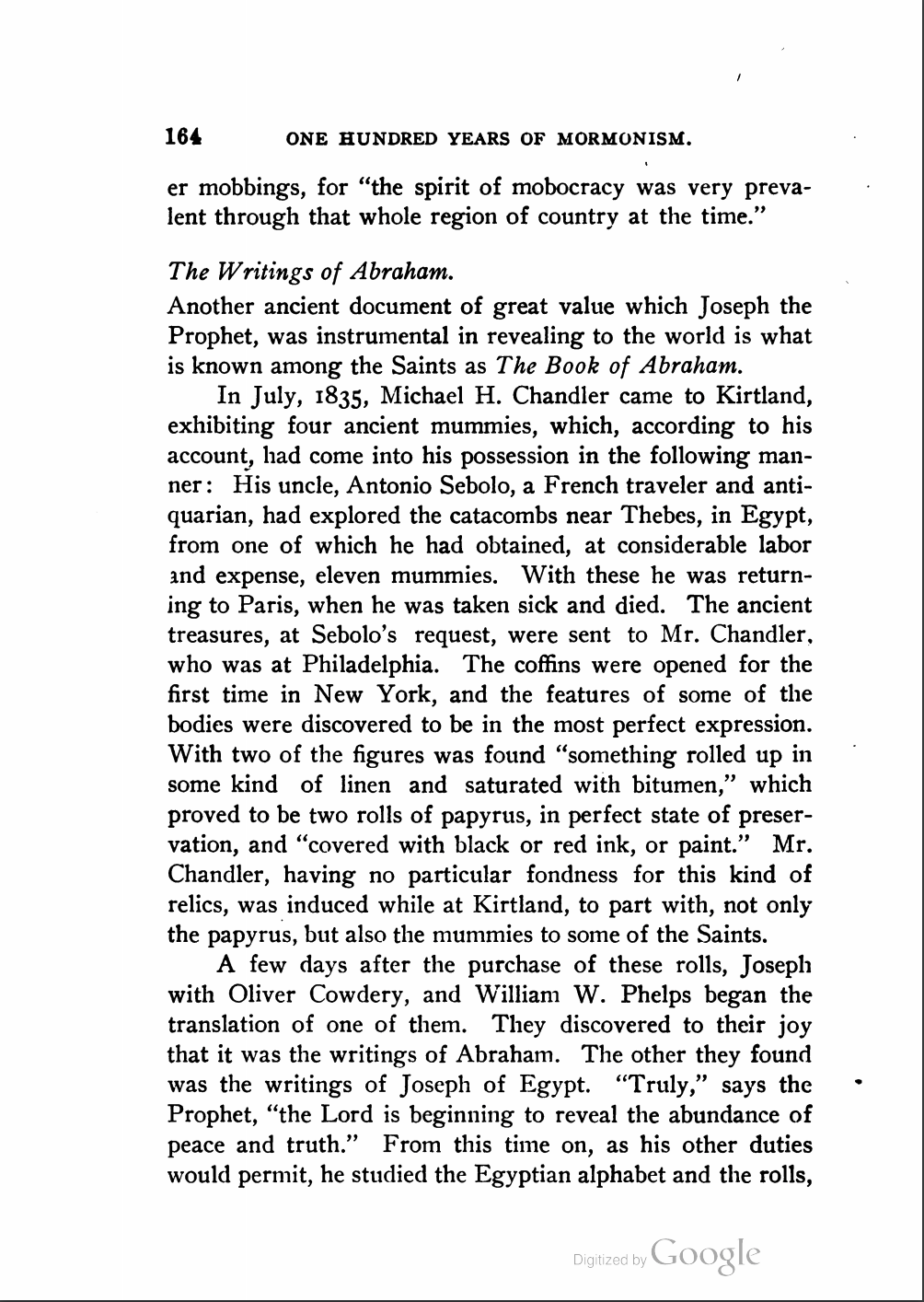JHE gives overview of coming forth of BOA, says text was "reveal[ed] to the world" by JS.
- Type
- Book
- Source
- John Henry Evans LDS
- Hearsay
- DirectLateSecondary
- Reference
John Henry Evans, One Hundred Years of Mormonism (Salt Lake City: The Deseret News, 1905), 164–165
- Scribe/Publisher
- Deseret News
- People
- Jared Carter, Brigham Young, John Henry Evans, John Taylor, Antonio Lebolo, Abraham, Joseph, Michael Chandler, Joseph Smith, Jr., Oliver Cowdery, William McLellin
- Audience
- Latter-day Saints, Reading Public
- Transcription
The Writings of Abraham.
Another ancient document of great value which Joseph the Prophet, was instrumental in revealing to the world is what is known among the Saints as The Book of Abraham.
In July, 1835, Michael H. Chandler came to Kirtland, exhibiting four ancient mummies, which, according to his account, had come into his possession in the following manner: His uncle, Antonio Sebolo [Lebolo], a French traveler and antiquarian, had explored the catacombs near Thebes, in Egypt, from one of which he had obtained, at considerable labor and expense, eleven mummies. With these he was returning to Paris, when he was taken sick and died. The ancient treasures, at Sebolo's request, were sent to Mr. Chandler, who was at Philadelphia. The coffins were opened for the first time in New York, and the features of some of the bodies were discovered to be in the most perfect expression. With two of the figures was found "something rolled up in some kind of linen and saturated with bitumen,” which proved to be two rolls of papyrus, in perfect state of preservation, and "covered with black or red ink, or paint.” Mr. Chandler, having no particular fondness for this kind of relics, was induced while at Kirtland, to part with, not only the papyrus, but also the mummies to some of the Saints.
A few days after the purchase of these rolls, Joseph with Oliver Cowdery, and William W. Phelps began the translation of one of them. They discovered to their joy that it was the writings of Abraham. The other they found was the writings of Joseph of Egypt. “Truly ,” says the Prophet, "the Lord is beginning to reveal the abundance of peace and truth." From this time on, as his other duties would permit, he studied the Egyptian alphabet and the rolls, showing them meantime to friends and strangers who chanced to appear. Among those to whom he made explanations and exhibitions were Elders William E. M'Lellin, Brigham Young, Jared Carter, and John Taylor. Finally, the translation of the Book of Abraham was completed and published to the world, first in the Times and Seasons, and afterwards as part of the Pearl of Great Price.
The Book of Joseph, it seems, was never published, if it was ever translated. The mummies, with which the rolls of papyrus were found, were kept for several years by Lucy Smith, Joseph's mother, who had them on exhibition at Nauvoo; but they finally found their way to the Chicago museum, where they were destroyed in the fire that occurred there in 1871.
The Book of Abraham, as published in the Pearl of Great Price, is a very remarkable work in many respects. It is in the main an autobiographical sketch of the ancient patriarch, though it is far more valuable for the great truths it contains in relation to the customs of the Egyptians and Chaldeans of that early day; the location, relative positions, and operations of the heavenly bodies, which Abraham learned through the urim and thummim; the doctrine of pre-existence, which is set forth with such rare clearness; and the creation of the earth, which supplements very beautifully the account given in Genesis.
- Citations in Mormonr Qnas
The B. H. Roberts Foundation is not owned by, operated by, or affiliated with the Church of Jesus Christ of Latter-day Saints.


